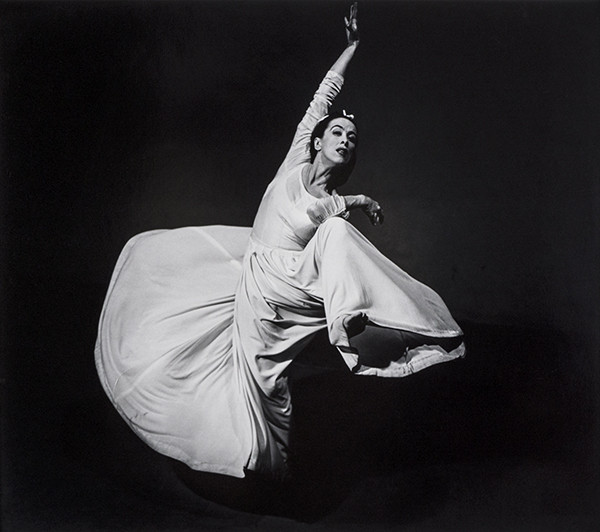In 1936, Barbara Morgan joined creative forces with the modern dance choreographer Martha Graham to create a series of photographs that would redefine their respective disciplines. Born in Buffalo, Kansas on July 8, 1900, Morgan went on to study fine arts at the University of California Los Angeles (UCLA). The university’s curriculum, focusing on early Asian and European arts, exposed Morgan to different aesthetic ideologies.[1] Morgan integrated the Chinese philosophy of “rhythmic vitality” and the Japanese concept of esoragoto, which is the process of “emptying the mind and becoming one with the subject of art,” into her work.[2] These ideas would later play an integral role in Morgan’s collaboration with Graham. They worked together from 1936 to 1940 on a photography book entitled Martha Graham: Sixteen Dances in Photographs (1941). It contained depictions of dances at their peak moments. Each image was imbued with symbolic meaning that transformed the dance into visual poetry. In order to achieve this goal, Morgan would watch multiple performances and, applying the theory of esoragoto, would then envision the most memorable moments. The climactic moments of the dance would be the focus of Morgan’s photographs that she would later recreate in the controlled environment of a studio.
One of the most notable photographs from this series is Martha Graham, Letter to the World (Swirl-Kick, Frontal View), which captures the culminating moment of the dance: the kick. The photograph captures the essence of Emily Dickinson’s poem, which bears the same title, and reveals the poet’s vulnerability in entrusting her work to her audience. Morgan’s image presents Graham embodying Dickinson’s character through the juxtaposition of energetic and retracted movements.[3] Graham’s face is caught in a moment of strained emotion, evident from her raised eyebrows and mouth ajar. The dancer’s arms illustrate the poet’s hesitant leap of faith, her right arm stretched above her with her palm spread wide, her left arm bent backward, her hand contorted inward. This contrast is also evident in the pose of her legs, one outstretched, the other bent. The moment that Morgan captured confines the figure in total darkness, while also highlighting the subtleties in her expressive actions.
In another effort to create striking contrast, Morgan, realizing the opportunity lighting offers to suggest meaning, used the “psychological lighting of dance motion” to enhance the emotion in her photographs.[4] Lighting had more than a utilitarian purpose and could symbolize divine inspiration. The lighting in Letter to the World illuminates Graham while creating rich shadows in the draping of her costume. Though the light draws attention to the subject, it also isolates her, thus allowing Morgan to connote an air of solitude. There is an extreme contrast between the black background and the paleness of the illuminated figure. Intense values heighten the emotion of the image and further reveal Dickinson’s isolation. The composition of the piece reflects a balance between negative and positive space. The emphasis on the contrast of light and energy results in a dramatic, impactful image. Morgan’s unique creative process and stark presentation enable viewers to see Graham’s work in a new light, revealing new layers of meaning and the possibility of fresh interpretation.
[1] Deba P. Patnaik, Aperture Masters of Photography: Barbara Morgan, (Hong Kong: Aperture Foundation Inc., 1999), 5.
[2] ibid.
[3] Jack Anderson, “Morgan’s Graham: Images of Images,” Dance Chronicle 4, no. 3: 335, (1981): 334-337. doi: 134.173.151.25.
[4] Leonard N. Amico and Stephen Robert Edidin, The Photographs of Barbara Morgan, (Massachusetts: Williamson College Museum of Art, 1978), 10.
Image: Barbara Morgan, Martha Graham, Letter to the World (Swirl Kick, Frontal View), 1940, printed circa 1980, gelatin silver print, 13 1/2 x 15 1/2 inches on 16 x 20 sheet, ©Barbara Morgan, The Barbara Morgan Archive, the Sisters of Browning in honor of Mary Weiss, Scripps College, Claremont, CA
Jocelyn Lo, Getty Collections/Conservation Summer Intern, 2015


